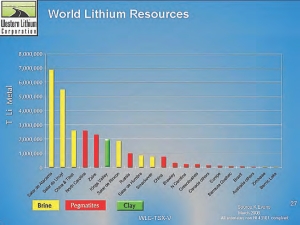Toyota’s announcement at the North American International Auto Show in Detroit earlier this month that its new plug-in hybrid will be powered by lithium ion batteries was hailed as a triumph for companies with lithium properties like Western Lithium Canada (WLC-V, WLCDF-O).
“We’ve got a tidal wave behind us in terms of interest in this sector,” Jay Chmelauskas, the company’s president, told The Northern Miner in a telephone interview from his Vancouver office. “The technology is now at the confidence level that they are going to commercialize it for their vehicles.”
And as more and more automakers — particularly the near-bankrupt North American ones — begin to overhaul their outdated business models and introduce new electric and hybrid vehicles, the demand for lithium will only grow. “They’re being forced to reinvent their businesses and come out with the next generation of cars,” Chmelauskas says. “Where are you going to get the lithium?”
Currently lithium is produced in Chile, Argentina, Australia and China, with new production likely to come from Zaire and Bolivia, Chmelauskas explains.
If one looks at the size of the deposits outside the U. S., he adds, there are really only a handful that are of the scale of what Western Lithium has in Nevada and there are certain countries “which we believe are less likely to be developed for technical and political reasons.”
Currently, lithium prices are at about US$3.50 per lb., up from about US$1 per lb. in mid-2003. Historically, the price has been supported by demand from the electronics industry — from producers of everything from computers to electric drills. But when hybrid and electric cars begin to come on the market in 2010 and beyond, that demand demographic is only going to get bigger, Chmelauskas predicts.
Referring to the decade-long debate over which technology is better: nickel-metal-hydride batteries or lithium batteries, Chmelauskas argues that the charge per weight for a lithium battery is three to four times better than for nickel-metal-hydride batteries, which means you can drive three to four times as far with the same weight of battery.
Historically, lithium carbonate has come from hard-rock mines or pegmatites. But in the early 1980s, companies started producing lithium carbonate from brine or salt solutions, which basically put the pegmatite producers out of business, Chmelauskas says.
By contrast, Western Lithium’s source of lithium is Nevada’s hectorite clay, which Chmelauskas believes will be competitive with the higher-cost brines.
“We’re not going to beat the brine producers, but we believe we’ll be right behind them,” he says.
On Jan. 20, Western Lithium released a new resource estimate on its King’s Valley property in northwestern Nevada, about 100 km north-northwest of Winnemucca.
The new lithium resource focuses on only one of the property’s five mineralized lenses and “supports work previously carried out by Chevron Resources in the 1970s and 1980s, which indicated that the King’s Valley property may contain one of the largest lithium resources in the world.”
The PCD lens contains indicated resources of 48.1 million tonnes grading 0.27% lithium, or 688,000 tonnes of lithium carbonate equivalent (LCE). Inferred resources amount to 42.3 million tonnes grading 0.27% lithium, for 606,000 tonnes LCE, both at a cutoff grade of 0.2% lithium.
Western Lithium believes the resource potentially supports the first stage of production at King’s Valley at a rate of 20,000 tonnes per year LCE.
Chevron identified five lithium-bearing hectorite clay lenses and Western Lithium selected the first-stage PCD lens as the lens with the greatest potential for first-stage development because its proximity to infrastructure such as roads and power.
Western Lithium drilled 37 core and eight reverse-circulation holes at the first-stage PCD lens in 2007 and 2008 to confirm Chevron’s earlier work and to bring the resource up to National Instrument 43-101 standards.
Now Western Lithium is conducting further engineering work to assess scoping-level economics. That study is expected later this year.
The company is working on permitting the King’s Valley property for mining and processing of the lithium-bearing clays.
The company is optimistic that these will go through as the project supports new energy independence policies coming from the new administration in Washington and the development of energy- efficient electric/hybrid cars by domestic and international manufacturers.
The PCD lens is the southernmost mineralized lens on the prop-of erty and appears to be one of the smallest of the known mineralized areas, the company says.
The lens comprises relatively unaltered volcaniclastic sandstone and claystones, which are the dominant rock types. Lithiumrich beds are generally 1 to 10 metres thick with some areas up to 60 metres thick. Colluvium as thick as 10 metres covers much of the area.
Western Lithium has leased claims from Western Uranium Corp. (WUC-V, WURNF-O) for the purpose of lithium exploration and exploitation.
The lease agreement, signed on Dec. 20 in 2007, gives Western Lithium exclusive rights to explore, develop and mine all lithium deposits discovered on the claims.
Under the agreement, Western Lithium will be subject to a net smelter return royalty equal to 1.5% of the net smelter returns, a net profits royalty equal to 3.5% of the net profits from the production, and a schedule of payments ranging from US$75,000- 200,000 per year over the 30-year lease term totalling US$4.4 million.
Western Lithium is currently trading at about 59¢ per share. It has a 52-week trading range of 10¢- $1.17 per share, and 51.2 million shares outstanding.


Be the first to comment on "Western Lithium Hopes To Ride The ‘Tidal Wave’"